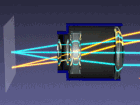Beam path

As the optical path of the geometrical course of light rays by means of optical devices (is microscopes , telescopes , projectors , Umbildegeräte, spectrographs , etc.), respectively. The associated subject area is geometric optics (ray optics ). To simplify matters, it is assumed that light consists of small particles ( photons ) that move on straight paths as long as they are not deflected by lenses , mirrors (planar arched ), prisms or other optical components. This term is also used for the direction of travel of X-rays .
In most optical instruments, the incoming light is bundled to the focal point by an objective made of lenses or a primary mirror , from where it is either viewed visually through an eyepiece or sent to another radiation receiver (photo camera, CCD sensor, spectrograph, etc.). Often the beam path is flat mirror deflected to him of observation should be more accessible.
Astronomical mirror telescopes are usually also equipped with secondary mirrors to extend the focal length, astrographs also to shorten it. In photography , on the other hand, sliding lens systems are used, for example as a zoom lens .
When designing an optical device, there is often a choice between lenses or mirrors as the main imaging elements. Lenses have the advantage of a rather straight overall structure, and larger distances between them can easily be bridged. Mirrors have advantages where a compact, "folded" construction is sought and where the observation of broad spectral ranges is concerned, since with them a typical lens error such as chromatic aberration does not occur in principle.
In technical terms, mirrors have the advantage that they can be mounted over the entire surface (not just on the edge like lenses). They can also be produced in larger dimensions, whereas telescope lenses are limited to a maximum of 1 m in diameter due to the bending of the lens . On the other hand, glass lenses are thermally more stable than most mirror materials in terms of changes in focal length and shape, as they have a lower coefficient of thermal expansion .
Optical devices with a beam path
A chained beam path is often used in projecting optical systems . Telecentric beam paths can be used if the image scale is to be independent of the object distance or the image distance or if distortions are to be avoided. In the case of pericentric beam paths , several side surfaces of an object can be recorded with a single image.
Below is a selection of optical devices in which the beam path plays an important role:
- Light microscope
- Lens telescope
-
Reflector telescope , especially those with a folded beam path,
- including Cassegrain , Coudé , Gregory and Nasmyth telescopes
- Confocal microscope
- sextant
- spectrometer
- Beam splitter
- Monochromator
- electron microscope
- Camera
- projector
- Biconvex lens